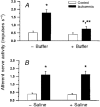Role of protons in activation of cardiac sympathetic C-fibre afferents during ischaemia in cats
- PMID: 10420020
- PMCID: PMC2269450
- DOI: 10.1111/j.1469-7793.1999.0857p.x
Role of protons in activation of cardiac sympathetic C-fibre afferents during ischaemia in cats
Abstract
1. Chest pain caused by myocardial ischaemia is mediated by cardiac sympathetic afferents. The mechanisms of activation of cardiac afferents during ischaemia remain poorly understood. Increased lactic acid production is associated closely with myocardial ischaemia. The present study examined the role of protons generated during ischaemia in activation of cardiac sympathetic C-fibre afferents. 2. Single-unit activity of cardiac afferents innervating both ventricles was recorded from the left sympathetic chain in anaesthetized cats. Epicardial tissue pH was measured within 1-1.5 mm of the surface by a pH-sensitive needle electrode. Responses of cardiac afferents to myocardial ischaemia, lactic acid, sodium lactate, acidic phosphate buffer and hypercapnia were determined. 3. Occlusion of the coronary artery for 5 min decreased epicardial tissue pH from 7.35 +/- 0.21 to 6.98 +/- 0.22 (P < 0.05). Epicardial placement of isotonic neutral phosphate buffer, but not saline, prevented the ischaemia-induced decrease in epicardial pH. This manoeuvre significantly attenuated the response of 16 afferents to 5 min of ischaemia (1.56 +/- 0.23 pre-treatment vs. 0.67 +/- 0.18 impulses s-1). Topical application of 10-100 microg ml-1 of lactic acid, but not sodium lactate, concentration-dependently stimulated 18 cardiac afferents. Inhalation with high-CO2 gas failed to activate 12 separate cardiac afferents. Furthermore, lactic acid stimulated cardiac afferents to a greater extent than acidic phosphate buffer solution, applied at a similar pH to the same afferents. 4. Collectively, this study provides important in vivo evidence that protons contribute to activation/sensitization of cardiac sympathetic C-fibre afferents during myocardial ischaemia.
Figures








Similar articles
-
Xanthine oxidase, but not neutrophils, contributes to activation of cardiac sympathetic afferents during myocardial ischaemia in cats.J Physiol. 2002 Aug 15;543(Pt 1):327-36. doi: 10.1113/jphysiol.2001.013482. J Physiol. 2002. PMID: 12181303 Free PMC article.
-
Role of 5-HT3 receptors in activation of abdominal sympathetic C fibre afferents during ischaemia in cats.J Physiol. 1998 Jun 15;509 ( Pt 3)(Pt 3):729-40. doi: 10.1111/j.1469-7793.1998.729bm.x. J Physiol. 1998. PMID: 9596795 Free PMC article.
-
Activated platelets contribute to stimulation of cardiac afferents during ischaemia in cats: role of 5-HT(3) receptors.J Physiol. 2002 Nov 1;544(3):897-912. doi: 10.1113/jphysiol.2002.023374. J Physiol. 2002. PMID: 12411532 Free PMC article.
-
Reflexes mediated by cardiac sympathetic afferents during myocardial ischaemia: role of adenosine.Clin Exp Pharmacol Physiol. 1996 Aug;23(8):709-14. doi: 10.1111/j.1440-1681.1996.tb01763.x. Clin Exp Pharmacol Physiol. 1996. PMID: 8886495 Review.
-
Cardiac sympathetic afferent activation provoked by myocardial ischemia and reperfusion. Mechanisms and reflexes.Ann N Y Acad Sci. 2001 Jun;940:74-95. doi: 10.1111/j.1749-6632.2001.tb03668.x. Ann N Y Acad Sci. 2001. PMID: 11458709 Review.
Cited by
-
The receptor site of the spider toxin PcTx1 on the proton-gated cation channel ASIC1a.J Physiol. 2006 Jan 15;570(Pt 2):339-54. doi: 10.1113/jphysiol.2005.095810. Epub 2005 Nov 10. J Physiol. 2006. PMID: 16284080 Free PMC article.
-
Dorsal root ganglion neurons innervating skeletal muscle respond to physiological combinations of protons, ATP, and lactate mediated by ASIC, P2X, and TRPV1.J Neurophysiol. 2008 Sep;100(3):1184-201. doi: 10.1152/jn.01344.2007. Epub 2008 May 28. J Neurophysiol. 2008. PMID: 18509077 Free PMC article.
-
A new sea anemone peptide, APETx2, inhibits ASIC3, a major acid-sensitive channel in sensory neurons.EMBO J. 2004 Apr 7;23(7):1516-25. doi: 10.1038/sj.emboj.7600177. Epub 2004 Mar 25. EMBO J. 2004. PMID: 15044953 Free PMC article.
-
Trigeminal nerve stimulation: a current state-of-the-art review.Bioelectron Med. 2023 Dec 13;9(1):30. doi: 10.1186/s42234-023-00128-z. Bioelectron Med. 2023. PMID: 38087375 Free PMC article. Review.
-
Citric Acid in Drug Formulations Causes Pain by Potentiating Acid-Sensing Ion Channel 1.J Neurosci. 2021 May 26;41(21):4596-4606. doi: 10.1523/JNEUROSCI.2087-20.2021. Epub 2021 Apr 22. J Neurosci. 2021. PMID: 33888605 Free PMC article.
References
-
- Abe T, Morgan D, Sengupta JN, Gebhart GF, Gutterman DD. Attenuation of ischemia-induced activation of cardiac sympathetic afferents following brief myocardial ischemia in cats. Journal of the Autonomic Nervous System. 1998;71:28–36. - PubMed
-
- Barber MJ, Mueller TM, Davies BG, Zipes DP. Phenol topically applied to canine left ventricular epicardium interrupts sympathetic but not vagal afferents. Circulation Research. 1984;55:532–544. - PubMed
-
- Bosnjak ZJ, Zuperku EJ, Coon RL, Kampine JP. Acute coronary artery occlusion and cardiac sympathetic afferent nerve activity. Proceedings of Society for Experimental Biology & Medicine. 1979;161:142–148. - PubMed
Publication types
MeSH terms
Substances
Grants and funding
LinkOut - more resources
Full Text Sources
Medical
Miscellaneous

